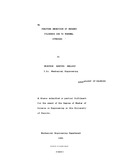| dc.contributor.author | Bellihu, Negussie A | |
| dc.date.accessioned | 2013-04-18T08:36:22Z | |
| dc.date.available | 2013-04-18T08:36:22Z | |
| dc.date.issued | 1986 | |
| dc.identifier.citation | Masters of science in engineering | en |
| dc.identifier.uri | http://erepository.uonbi.ac.ke:8080/xmlui/handle/123456789/16339 | |
| dc.description.abstract | Recently developed domestic stoves are equipped
with ceramic lining that surround the fire. During use
these linings are exposed to thermal stresses arising due to
the temperature gradients across the walls of the linings
and restraint of expansion resulting from the presence of
different phases with different coefficients of thermal
expansion in a multiphase ceramic system. These stresses
cause the ceramic lining to fracture after a considerably
short service life.
A numerical model is designed in order to study the
thermal and stress characteristics of the lining. The
effects of geometric parameters,thermal conductivity, specific
heat capacity, density and heat transfer conditions have
been studied. Experimental temperature and strain analyses
were employed on hollow cylinders produced from Nyeri clay
to establish the validity of the numerical results Thermal fracture behaviour was investigated using
quenching method of quenching of cylinderical specimens from a
certain preselected higher temperature.
Some specimens were produced from clay and sand
mixture from Maragua and others from clay from Nyeri Chemical canposi tion of the specirrens was determined and
thermal and physical properties were measured and/or
estimated.
Thermal shock behaviour was monitored by the use
of low frequency (40 kHz) longitudinal ultrasonic waves and
four points flexural loading. The minimum thennal shock
severity required to initiate cracks and damage caused after
cracking was determined.
Thennal fatigue behaviour was monitored by visually
observing the fonnation and propagation of cracks on the
specimen surfaces. It was possible to construct the 'thermal
shock severity - probability - tirre' (T-SPI') diagram and
hence use the result to predict the thermal fatigue life.
Use of ultrasonic technique was extended so as to monitor
thermal fatigue and decrease in the speed of propagation
of ultrasonic waves with number of thennal cycles (shocks)was obtained.
It was found that after several thermal shocks the
Nyeri clay suffered more damage (loss of strength) than the
~
Maragua clay. The Maragua clay was found to have a longer
fatigue life than the Nyeri clay. Use of ultrasonic wave
to monitor fatigUe was found to be applicable to the Nyeri
clay whereas there was an insignificant interaction effect between the measured speed of ultrasonic pressure waves
through the Maragua samples and the numbers of thermal
shocks they were Subjected to.
Based on these conclusions, a number of suggestions
have been made as to the future work on this project. | en |
| dc.language.iso | en | en |
| dc.title | Fracture behaviour of ceramic cylinders due to thermal stresses | en |
| dc.type | Thesis | en |
| local.publisher | Department of mechanical and manufacturing engineering | en |

